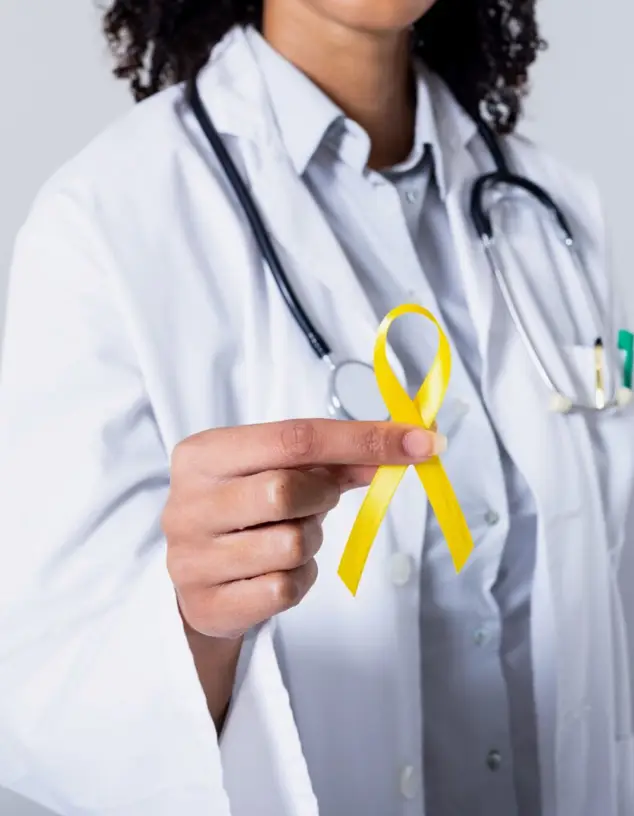What is Sarcoma?

About Sarcoma
Sarcoma is a type of cancer that begins in the connective tissues of the body. These tissues include fat, blood vessels, nerves, bones, muscles, deep layers of the skin, tendons, and cartilage. Sarcoma often appears as a tumor, which may feel like a lump, bump, or mass.
Sarcomas are grouped into two main categories: bone tumors and soft tissue tumors. Each category includes more specific subtypes based on the kind of cells that make up the tumor. There are more than one hundred known types of sarcoma, and many of them are considered rare.
1.7%
Of all new cancer diagnoses in the U.S. are sarcoma
83%
5-year survival rate for patients with localized sarcoma
17k
Newly diagnosed patients each year in the United States
How Rare are Sarcoma Cancers?
Of the 1.7 million people who are diagnosed with cancer in the United States each year:

About 1% (17,000) will be diagnosed with sarcoma cancer.

Some sarcomas are so rare that only a few people are diagnosed with that type each year.

In children under age 18, where cancer is rare already, sarcomas are in the top 5 most diagnosed cancers.
How Can You Diagnose Sarcomas?
Sometimes a cancer diagnosis is made quickly, especially when symptoms are clear and a person receives prompt medical attention. Diagnosing a new sarcoma can take longer, and this can be confusing or stressful for patients and families. A few reasons include:
Symptoms may feel vague or familiar. Many early signs of sarcoma, such as a lump, bump, or ongoing pain in a joint, are common experiences that do not always point to cancer.
Sarcoma can begin in many places. Because these tumors can form almost anywhere in the body, they may go unnoticed for some time before they cause concern.
Sarcomas may be mistaken for more common conditions. Since noncancerous issues are far more likely, sarcomas are sometimes misdiagnosed as an injury, a pulled muscle, or a benign fatty tumor known as a lipoma.
If you or a loved one is seeking clarity, know that you are not alone. Many people reach a sarcoma diagnosis only after several steps, and support is available throughout the process.
Diagnosing Sarcomas?
Sometimes the diagnosis of cancer comes quickly, if a person has obvious symptoms and received prompt evaluation. However, diagnosing a new sarcoma can sometimes be challenging. Some reasons include:

The symptoms might be vague. The symptoms are ones that many people experience, such as a lump bump or pain in a joint.

Sarcoma tumors can form almost anywhere in the body and may be present for a long time before they are recognized.

Sarcomas can be misdiagnosed. Since non-cancerous diagnoses are far more common, sarcoma tumors can be easily mistaken for trauma, a “pulled muscle” or a benign fatty tumor called lipoma.
What We Know About The Causes Of Sarcoma?
Sarcomas are rare cancers, and because they occur in many different forms, researchers are still learning what causes them. Many studies group several types of sarcoma together so scientists can gather enough information to look for patterns. This approach helps advance research, even though each sarcoma subtype has its own unique characteristics. Here is what we do know:
Genetic Causes
Cancer begins when something changes in the DNA of a cell. DNA acts as the body’s blueprint, and changes to that blueprint are called mutations.
Some mutations are present at birth, while others develop over time. Most are harmless, but certain mutations can cause cells to grow in ways they should not, which can lead to cancer.
Most gene mutations happen by chance. A smaller number are inherited from a parent. Inherited genetic conditions account for about five to ten percent of all cancers, and only a small portion of those are associated with sarcoma.When a hereditary risk is suspected, a doctor may recommend genetic testing through a simple blood or saliva sample.
Environmental Causes
While most sarcomas cannot be linked to a specific cause, a few environmental factors are known to increase risk:
A viral infection called Human Herpesvirus 8 (HHV-8) can lead to a type of sarcoma known as Kaposi sarcoma. This is more common in people with weakened immune systems, including those living with AIDS.
Previous treatment with ionizing radiation or certain chemotherapy drugs may slightly increase the chance of developing a sarcoma later in life. This is rare, and the benefits of cancer treatment almost always outweigh this risk.
Other Changes in Cells
Even when no clear cause is identified, changes in DNA can still occur throughout life. The body works continuously to repair these changes, but sometimes a harmful mutation slips through and allows cells to grow out of control. Learning about the specific genetic changes inside a sarcoma tumor can help guide treatment decisions and identify whether someone may be eligible for targeted therapies or clinical trials.
Tumor Mutation Burden
Sarcoma tumors vary widely in the number of genetic changes they carry. This is known as the tumor
mutational burden. A tumor with more mutations may respond differently to certain treatments. Understanding a tumor’s mutation profile helps doctors consider newer therapies and evaluate clinical trial options.
Additional Resources
Types Of Sarcoma Cancers
Soft Tissue Sarcomas
Bone Sarcomas
Soft Tissue Sarcomas
Soft tissue sarcoma tumors can occur in muscles, fat, nerves, blood vessels, tendons, and other soft tissues that support, surround, or protect body organs and joints. Soft tissue sarcomas can be found anywhere in the body, from head to toe, but they are more often found in the extremities, such as in the arms or legs.

Approximately three-quarters of people diagnosed with sarcoma will be diagnosed with a type of soft tissue sarcoma. There are many types of soft tissue sarcoma. Some of those types are so rare that only a few cases will be diagnosed in the United States each year.

In their early stages, soft tissue sarcoma rarely show any symptoms. Because soft tissue is very elastic, tumors can grow quite large before they are felt as a lump or bump.

Pain may occur when a sarcoma starts to press on nearby muscles and nerves.

Imaging such as MRI scans, can help determine if a lump or mass has features consistent with a sarcoma.

The only way to make a definitive diagnosis of soft tissue sarcoma is through a biopsy, which is when either the entire tumor or a small piece of it is surgically removed for testing. This is best performed by a skilled surgeon who is very familiar with sarcoma, and who will take great care in not allowing the spread of cancer cells during initial biopsies.
The most common types of soft tissue sarcoma cancers are described below. This is not intended to be a complete list and may not contain the specific sarcoma cancer type that you (or your loved one) have been diagnosed with. It is always best to work closely with your own oncologist and sarcoma cancer team who will help get you all the additional information that you will want to know.
Angiosarcomas
Type:
Soft tissue tumors
How does it appear?
Most patients have no symptoms (i.e., are asymptomatic).
They will appear as a raised, purple area of skin that resembles a bruise, growing over time.
May be painful or bleed at the tumor site.
Can occur anywhere in the body, but most often in the skin, head, or neck.
General Description
Angiosarcoma is a connective tissue sarcoma tumor that grows from the cells that line blood vessels and lymph channels (“Angio”). They represent approximately 1-2% of all sarcoma cancers and is seen most commonly in individuals above the age of 70, but can also occur at any age.
Can be caused by “lymphedema”, which is swelling due to extra fluid (lymph) collecting in tissues, often in the arms and legs.
Other causes of these tumors include radiation exposure and/or exposure to chemicals, such as vinyl chloride, arsenic, and thorium dioxide.
Dermatofibrosarcoma Protuberans(DFSP)
Type:
Soft tissue tumors
How does it appear?
Often starts as a small, firm patch of skin that can be various tones of purple or red.
Grows slowly over months to years and can become a raised nodule under the skin.
General Description
A Dermatofibrosarcoma Protuberans (DFSP) tumor arises from connective tissue in the middle layer of the skin, known as the dermis layer.
Typically affects people ages 20-50.
Women and African Americans are more at risk.
Scars formed from burns or surgery can be risk factors.
There are many subtypes of these tumors that are based on the type of cells found in the dermis layer. These subtypes include Bednar tumors, Myxoid Dermatofibrosarcoma Protuberans tumors, and Giant Cell Fibroblastoma.
Related links
Desmoid Tumor (AKA Aggressive Fibromatosis)
Type:
Soft tissue tumors, not considered malignant
How does it appear?
Most patients have no symptoms (i.e., are asymptomatic).
There may be pain or swelling or a lump where the tumor is located.
Can occur anywhere in the body, but most often are found in the abdomen, arms, shoulders or legs.
They can be slow or fast growing.
General Description
A non-cancerous tumor of the connective tissue, which are tissues that connect, support, and/or separate organs.
These tumors can locally grow very large and can damage nearby organs, but they do not spread to other parts of the body
Desmoplastic Round Cell Tumor
Type:
Soft tissue tumors
How does it appear?
Appears in the abdomen and pelvic area of the body.
No symptoms initially but leads to one or a combination of the following symptoms: nausea and vomiting, diarrhea, constipation, abdominal swelling, abdominal pain and difficulty urinating.
General Description
A type of soft tissue sarcoma that begins on the tissue that lines the inside of the abdomen and pelvis called the peritoneum.
Most often occurs in white males between the ages of 10 and 30.
Epithelioid sarcoma
Type:
Soft tissue tumors
How does it appear?
Typically, it will appear as a small, painless, slow growing lump under the skin of a finger, hand, forearm, lower leg, or foot.
May be a sore or open wound that doesn’t heal.
General Description
Epithelioid sarcoma is a connective tissue tumor that grows from epithelial cells, which are cells that line the surfaces inside and outside of the body, including the skin, urinary tract, intestines, and other organs.
Most commonly seen among teenagers and young adults.
More common in men than women (2:1),
Related links
Fibrosarcoma
Type:
Soft tissue tumors
How does it appear?
Cancer that begins in the fibrous connective tissue located at the extremities of the arms or legs.
May lead to limping or difficulty in using legs, feet, arms, and hands.
General Description
The tumor cells at the primary sites frequently spread to nearby soft tissue.
Can occur in children and adults.
Infantile fibrosarcoma is the most frequent soft tissue sarcoma in children less than one year old. It presents as a growing mass at birth or soon after. This form has slower growth rate and is usually less aggressive than fibrosarcoma seen in older children.
Gastrointestinal stromal tumor (GIST)
Type:
Soft tissue tumors
How does it appear?
Symptoms vary based on size and location of tumors.
Small tumors may be asymptomatic while larger tumors may cause vomiting, GI bleeding, abdominal pain, nausea and weight loss.
General Description
A Gastrointestinal Stromal Tumor (GIST) is a sarcoma cancer that develops from the cells that help your intestines move food in your body.
Most commonly occurs in adults between the ages of 50 and 70, but can occur at any age.
Some association with rare genetic syndromes
Kaposi’s sarcoma
Type:
Soft tissue tumors
How does it appear?
Appears as painless, purple-ish spots on the legs, feet, or face.
Can also appear in genital areas, the mouth, lymph nodes, and, in severe cases, the digestive tract or lungs.
General Description
Kaposi’s sarcoma is a connective tissue tumor named after the Hungarian doctor who discovered it. These tumors grow from cells that line blood and lymph vessels.
Is caused by an infection with a virus called Human Herpes virus 8 (HHV-8).
Immune system damage or suppression (especially in patients with organ transplant or HIV/AIDs) allows the cells infected with HHV-8 virus to multiply and form tumors.
Related links
Leiomyosarcoma
Type:
Soft tissue tumors
How does it appear?
Tumors located deep in the body that may not present with any symptoms until they grow larger or causing pressure in the space they are growing.
May appear as painless masses below the skin.
Uterine leiomyosarcoma may present with pain pressure, and abnormal uterine bleeding, similar to benign fibroids.
General Description
Leiomyosarcoma is a connective tissue tumor that grows from the type of muscle found in the intestines, gastrointestinal tract, large blood vessels, and in the uterus of women.
Accounts for 5-10% of all soft tissue sarcoma tumors.
No proven relation to any environmental exposures or lifestyle choices.
Genetic conditions (Hereditary Retinoblastoma and Li Fraumeni Syndrome) may predispose patients to Leiomyosarcoma cancer.
Liposarcoma
Type:
Soft tissue tumors
How does it appear?
Can occur anywhere in the body, but are mostly found in the limbs, muscles and abdomen.
They are painless and slow growing so many patients may be symptom free (asymptomatic).
May appear as a growing lump under the skin of the arms or legs.
General Description
Liposarcoma is a connective tissue tumor that grows from fat cells located in deep connective tissues.
One of the most common soft tissue tumors mostly found in adults, but can occur at any age.
Some risk factors include exposure to chemical. carcinogens, previous ionizing radiation and chemotherapy treatments.
Malignant Peripheral Nerve Sheath Tumor (MPNST)
Type:
Soft tissue tumors
How does it appear?
Symptoms vary based on the size and location of tumors.
May experience pain, numbness, weakness, or a burning/tingling sensation in the extremities at the tumor site.
General Description
A malignant nerve sheath tumor (MPNST) is a sarcoma cancer that develops from the cells that surround and protect the nerves of the peripheral nervous system (outside of the brain and spinal cord).
Most commonly affects young and middle-aged adults.
50% of these tumors occurs in the setting of a genetic condition called Neurofibromatosis 1.
Related links
Myxofibrosarcoma
Type:
Soft tissue tumors
How does it appear?
Slow-growing, painless lump on extremities, such as arms or legs, that extends deep into tissues.
Symptoms be different based on size and location of tumors.
General Description
Myxofibrosarcoma is a connective tissue tumor that surrounds and separates muscles from each other and from the skin.
Mostly occurs in people between the ages of 50 and 70.
Slightly more common in men than women.
Difficult to distinguish from other soft tissue sarcoma tumors, which can result in delayed diagnosis.
Rhabdomyosarcoma
Type:
Soft tissue tumors
How does it appear?
May appear as a painless mass underneath the skin.
Are commonly found in the head and neck region, followed by the extremities, such as arms and legs.
General Description
Rhabdomyosarcoma is a connective tissue tumor that grows from skeletal muscles, such as the muscles in your arms, legs, abdominal wall, and back.
Mostly occurs in children and young adults, but can occur at any age.
Is associated with Neurofibromatosis, Li-Fraumeni, Beckwith-Wiedemann, and Costello syndromes.
Synovial Sarcoma
Type:
Soft tissue tumors
How does it appear?
Slow growing, painless mass found in the arms or legs where the joints are formed.
Masses may be painful if involving nerves.
General Description
Synovial sarcoma tumors develop from immature cells that line the inside of a joint (synovium).
Typically affects people ages 15-40, but can occur at any age.
No definite risk factors.
Has been associated with Chromosome 18 and Chromosome X Translocations.
Undifferentiated Pleomorphic Sarcoma
Type:
Soft tissue tumors
How does it appear?
Appears as a lump in the extremities, such as arms or legs, and can also occur behind abdominal organs.
Although it can be found in either soft tissues or bone, it is considered a soft tissue tumor.
General Description
An Undifferentiated Pleomorphic sarcoma tumor has cells of different sizes and shapes. The tissue type it originates from is not able to be identified, which is known as “undifferentiated”.
Formerly known as Malignant Fibrous Histiocytoma.
Typically affects older adults.
Previous ionizing radiation therapy is a risk factor.
Bone Sarcomas
Bone Sarcoma tumors develop in the bone tissue itself or in the cartilage that provides cushion between bones in the joints.

Approximately 3,600 new cases of bone sarcoma cancers are diagnosed in the United States each year, accounting for less than 0.2% of all cancers.

Unexplained pain that does not go away, and/or a lump that may appear under the skin, are the most common symptoms of this type of cancer.

As a tumor gets bigger, it can cause a joint, such as the knee or elbow, to swell, often being mistaken for an injury instead of a bone tumor. These tumors can also weaken the bones, causing easy fractures.

A variety of imaging, such as X-Rays, CT scan or an MRI scan, can decide if a lump or mass is a bone tumor.
An orthopedic bone surgeon, who is very familiar with sarcoma cancers, should be consulted for a diagnosis and surgical and treatment plans.

Bone sarcomas are diagnosed by either removing the entire tumor or a small piece of it through a surgical biopsy.
The most common types of bone sarcomas are described below. Working closely with your oncologist and cancer team will help get you all the information you need. This is not intended to be a complete list.
Chondrosarcoma
Type:
Bone tumors
How does it appear?
May feel a hard lump under the skin, causing pain, swelling, or limited movement.
Usually starts in the long bones of the arms, legs, or pelvis, often near the joints.
Because it is a sarcoma of the cartilage, tumors are often found near the joints.
General Description
Chondrosarcoma is a sarcoma that arises from cells that produce cartilage, which is connective tissue surrounding bones and other organs in the body.
Typically affects adults between the ages of 20 and 60.
These tumors are commonly found in men more than women.
This type of sarcoma is associated with other conditions, such as Ollier’s Disease, Maffucci Syndrome, and Multiple Hereditary Exostoses.
Chordoma Sarcoma
Type:
Bone tumors
How does it appear?
Can occur anywhere within the spine and the base of the skull/brain, causing pain and nerve symptoms, including tingling, numbness and weakness.
General Description
Chordoma sarcoma arises from cells that become the discs of the spine in the embryo. These cells typically go away after birth, but rarely some remain and become cancerous.
Occurs most often in adults between ages 40 and 60, more in men than women.
Can be caused by some hereditary conditions, such as familial Chordoma and Tuberous Sclerosis Complex.
Ewing’s Sarcoma
Type:
Bone tumors
How does it appear?
May feel a lump under the skin causing pain, swelling, or limited movement.
Typically develops in the pelvis, ribs and long bones (femur, tibia, humerus).
General Description
Ewing’s sarcoma is named after the American doctor who discovered this sarcoma tumor in the 1920’s. It is a tumor that arises from immature bone cells, but can also occur outside the bone in cartilage, nerves, or soft tissue.
Second most common type of bone cancer, behind Osteosarcoma.
Most often occurs in children and young adults between the ages of 10 and 20, but can also rarely occur in older adults.
Is more common in males than females.
Most cases involve a fusing of genetic material between chromosomes 11 and 22, causing the Ewing’s sarcoma gene (EWS) to be “turned on”.
Osteosarcoma
Type:
Bone tumors
How does it appear?
Can experience unexplained pain in an affected area, such as in the knee, which can cause a limp or similar disability.
Easy fractures can occur, due to the bone weakening by the tumor.
Most common tumor sites are found in the femur and tibia, both by the knee, and the humerus, near the shoulder.
General Description
Osteosarcoma tumors come from bone forming cells, called osteoblasts, in immature bone tissue.
Most common bone tumors.
Most commonly diagnosed in children and young adults, under the age of 25.
Can also occur in older adults
Awards and Certificates

America’s Best Charities

Charities Review Council

Charity Navigator

